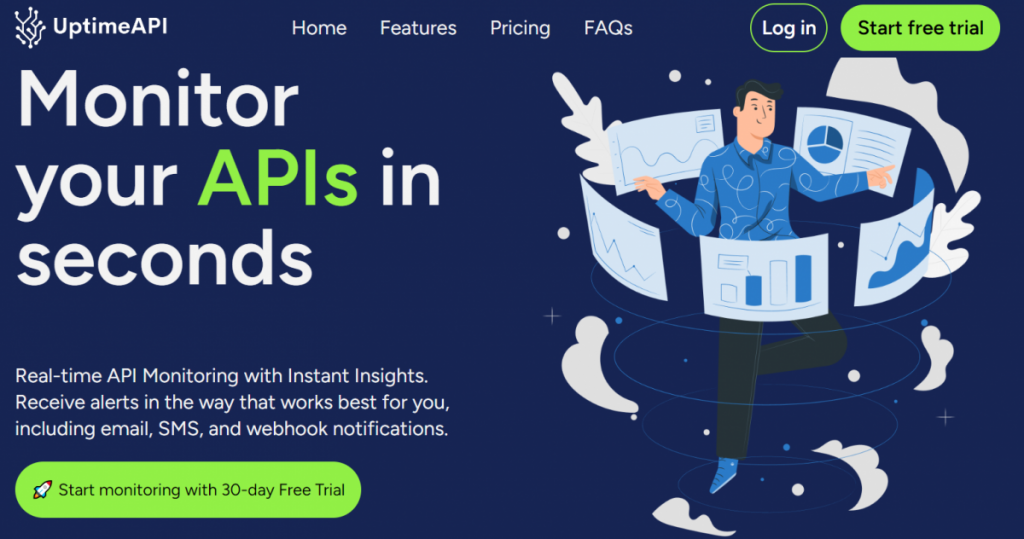As developers navigate the intricacies of building and maintaining REST APIs (Representational State Transfer Application Programming Interfaces), ensuring high uptime is a critical aspect of delivering reliable and responsive services. In this easy tutorial, we will explore the significance of REST API uptime, and more importantly, we’ll introduce UptimeAPI as a user-friendly tool for developers. Additionally, we’ll walk through the basics of interpreting API responses with UptimeAPI, making it a breeze for developers to monitor and optimize their REST APIs.
The Importance of REST API Uptime:

REST APIs form the backbone of modern web and mobile applications, enabling communication and data exchange between different systems. Users rely on the seamless functioning of these APIs for a smooth and uninterrupted experience. Downtime or performance issues can lead to frustrated users, lost revenue, and damage to the reputation of applications and businesses.
Monitoring the uptime of REST APIs is not just a best practice but a necessity. A proactive approach to identifying and addressing potential issues is crucial for maintaining a positive user experience. UptimeAPI simplifies this process, providing developers with an easy-to-use solution for real-time monitoring and ensuring optimal REST API performance.
Getting Started with UptimeAPI:
Step 1: Sign Up for UptimeAPI
Visit the UptimeAPI website and sign up for an account. UptimeAPI offers a straightforward onboarding process, and new users can quickly create an account to get started.
Step 2: Add Your REST API
Once logged in, navigate to the dashboard and add your REST API for monitoring. UptimeAPI supports easy integration with various APIs, making it suitable for a wide range of applications.
Step 3: Configure Monitoring Settings
Customize your monitoring settings based on your specific requirements. Set up parameters such as response time thresholds, error rate alerts, and frequency of checks to align with the unique characteristics of your REST API.
Step 4: Receive Real-Time Alerts
UptimeAPI provides real-time alerts to keep you informed about the health of your REST API. Whether it’s a sudden spike in response times or an increase in error rates, you’ll receive instant notifications to address issues promptly.
Understanding UptimeAPI’s API Responses:

API responses are the language through which UptimeAPI communicates crucial information about the performance and health of your REST API. Let’s break down the key components of UptimeAPI’s API responses:
- HTTP Status Codes:
- 200 OK: Indicates that the API request was successful.
- 404 Not Found: Signals that the requested resource was not found.
- 500 Internal Server Error: Points to an unexpected condition on the server, requiring attention.
- Response Time:
- UptimeAPI measures the time it takes for your REST API to respond to a request. Monitoring response time helps identify performance bottlenecks or issues that may affect user experience.
- Error Rates:
- UptimeAPI tracks the percentage of API requests that result in errors. High error rates may suggest issues with the functionality or connectivity of your REST API.
- Uptime Percentage:
- This metric represents the percentage of time your REST API has been available and responsive. Aim for a high uptime percentage to ensure continuous service availability for your users.
Tips for Optimizing REST API Uptime:
- Regularly Review Historical Data:
- Leverage UptimeAPI’s historical data analysis to identify trends and patterns. Regular reviews help you anticipate issues and optimize your REST API for peak performance.
- Customize Alerts Wisely:
- Set up customizable alerts based on specific thresholds. Customize alerts to align with the critical parameters of your REST API, ensuring that you are notified of issues that matter most to your application.
- Collaborate with Your Team:
- UptimeAPI allows for collaboration by providing multiple user accounts. Ensure that relevant team members have access to monitoring data and alerts to foster a collaborative approach to issue resolution.
Conclusion:
REST API uptime is a cornerstone of delivering reliable and responsive services, and UptimeAPI stands out as a user-friendly solution for developers. This easy tutorial has introduced the significance of monitoring REST API uptime, guided developers through the setup process on UptimeAPI, and explained how to interpret crucial API responses. By incorporating UptimeAPI into your development workflow, you can ensure the optimal performance of your REST API and deliver a positive user experience for your application’s users.
Read More: Company profile APIUsage Cases

